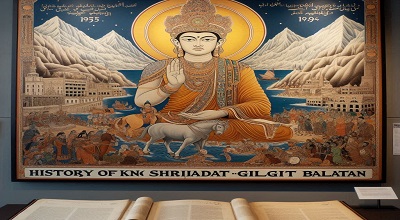History of King Shri Badat
The history of King Shri Badat, also known as the Cannibal King, is deeply rooted in the folklore and traditions of Gilgit-Baltistan. His story, a blend of historical events and mythological elements, offers a fascinating glimpse into the region’s past and its cultural narratives. This tale is often associated with the Buddhist Jatakas. Which are a collection of stories about the previous lives of the Buddha.
The Historical Background
King Shri Badat was the last Buddhist ruler of Gilgit, reigning during the 7th to 8th centuries AD. His reign marks the end of the Buddhist era in Gilgit-Baltistan, a region that has a rich history of Buddhist influence dating back to the reign of Emperor Ashoka in the 3rd century BCE. The Patola Shahi dynasty, to which Shri Badat belonged, was instrumental in spreading Buddhism in the region.
The Myth of Cannibalism
The legend of Shri Badat is shrouded in mystery and macabre tales. According to local folklore, Shri Badat developed a taste for human flesh, a trait that turned him into a feared cannibal king. This transformation is eerily reminiscent of stories from the Buddhist Jatakas, where kings and rulers often face moral and ethical dilemmas. Shri Badat’s cannibalism is said to have begun inadvertently, leading to a reign of terror. Where he preyed upon his people, especially infants.
Cultural Significance and the Nasalo Festival
The story of Shri Badat has transcended generations, influencing local customs and traditions. One such tradition is the Nasalo festival, celebrated in remembrance of the king’s death. During this festival, animals are slaughtered. And their meat is preserved to survive the harsh winter months. This practice is believed to be a continuation of ancient rites to ensure protection against the king’s return. The festival involves bonfires, folk songs, and dances, reflecting the community’s resilience and cultural heritage.
The Demise of Shri Badat
The downfall of Shri Badat is a tale of cunning and bravery. According to legend, Shri Badat’s life was tied to a mystical object hidden within his fortress. His daughter, Nur Bakht, and her lover, Prince Azur, devised a plan to discover this secret and end the king’s tyranny. After a series of deceptions and confrontations. They learned that Shri Badat’s life force was concealed in a butter-like substance stored in a hidden location. Azur and the villagers set a trap, ultimately leading to Shri Badat’s death and the liberation of the region.
The Impact of Shri Badat’s Rule
Shri Badat’s rule, despite its dark aspects, left a lasting legacy on Gilgit-Baltistan. His reign is a critical juncture in the region’s history, marking the transition from Buddhist to Islamic dominance. The narrative of Shri Badat serves as a cautionary tale about power and morality, echoing themes found in many Jataka stories where rulers face the consequences of their actions.
The Jataka Connection
The association of Shri Badat’s story with the Buddhist Jatakas highlights the moral and ethical undertones of his legend. Jataka tales often depict the Buddha’s previous lives, emphasizing virtues such as compassion, wisdom, and humility. The tale of Shri Badat, with its elements of redemption and justice, aligns with these moral narratives, providing a framework to understand his story beyond mere folklore.
Modern Interpretations and Research
Contemporary researchers and historians have explored the legend of Shri Badat, seeking to unravel the historical truths behind the myths. Studies suggest that the story may have been influenced by various cultural and religious transitions in the region. The blending of Buddhist, Hindu, and local tribal elements in Shri Badat’s legend reflects the diverse cultural fabric of Gilgit-Baltistan.
Conclusion
The legend of King Shri Badat is a rich tapestry of history, myth, and cultural traditions. It serves as a reminder of the complex interplay between historical events and their mythological retellings. The story of Shri Badat, whether viewed as a cautionary tale or a historical account. Continues to captivate and inspire the people of Gilgit-Baltistan. Preserving the region’s unique heritage for future generations.
References
- “Shri Badat The Cannibal King: A Buddhist Jataka from Gilgit” – Mock and O’Neil.
- “The legend of Shri Badat” – The Nation.
- “Nasalo – Wikipedia”.
- “Shri Badat: The Cannibal King” (folklorist).
